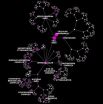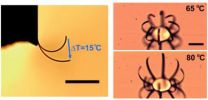(Press-News.org) A new model of the how the protein coat (capsid) of viruses assembles, published in BioMed Central's open access journal BMC Biophysics, shows that the construction of intermediate structures prior to final capsid production (hierarchical assembly) can be more efficient than constructing the capsid protein by protein (direct assembly). The capsid enveloping a virus is essential for protection and propagation of the viral genome. Many viruses have evolved a self-assembly method which is so successful that the viral capsid can self assemble even when removed from its host cell.
The construction of large protein structures has been observed experimentally but the mechanism behind this is not well understood. Even the 'simple' icosahedral protein coat of the T1 virus requires integration of 60 protein components. Computational models of the physical interactions of component proteins are used to investigate the dynamics and physical constraints that regulate whether the components assemble correctly.
Using computer simulations a team from the Institute for Theoretical Physics and the Center for Quantitative Biology (BioQuant), University of Heidelberg, has compared direct and hierarchical assembly methods for T1 and T3 viruses. The team led by Ulrich S Schwarz, realised that direct assembly often led to the formation of unfavorable intermediates, especially when the dissociation rate was low, which hindered further assembly, causing the process to stall. In contrast, for many conditions hierarchical assembly was more reliable, especially if the bonds involved had a low dissociation rate.
Discussing the practical applications of these results, Dr Schwarz commented, "Hierarchical assembly has not been systematically investigated before. Theoretical models and computer simulations, like ours, can be used to understand the mechanism behind assembly of complex viruses and give an indication of how other large protein complexes assemble."
He continued, " With our computer simulations, we are now in a position to investigate systems which are too large to be studied by molecular resolution. This rational approach might have many applications not only in biomedicine, but also in materials science, where many researchers strive to learn from nature how to assembly complex structures."
INFORMATION:
Media Contact
Dr Hilary Glover
Scientific Press Officer, BioMed Central
Tel: +44 (0) 20 3192 2370
Mob: +44 (0) 778 698 1967
Email: hilary.glover@biomedcentral.com
Notes
1. Stochastic Dynamics of Virus Capsid Formation: Direct versus Hierarchical Self-Assembly
Johanna E Baschek, Heinrich CR Klein and Ulrich S Schwarz
BMC Biophysics (Section: Computational and theoretical biophysics) (in press)
Please name the journal in any story you write. If you are writing for the web, please link to the article. All articles are available free of charge, according to BioMed Central's open access policy.
Article citation and URL available on request on the day of publication.
Please credit images to Johanna E Baschek, Heinrich CR Klein and Ulrich S Schwarz. More images and videos are available on request.
2. BMC Biophysics is an open access journal publishing original peer-reviewed research articles in experimental and theoretical aspects of biological processes from the microscopic to macroscopic level, including thermodynamics, structural stability and dynamics, molecular biophysics, signalling, novel biophysical methods and computational biophysics.
3. BioMed Central is an STM (Science, Technology and Medicine) publisher which has pioneered the open access publishing model. All peer-reviewed research articles published by BioMed Central are made immediately and freely accessible online, and are licensed to allow redistribution and reuse. BioMed Central is part of Springer Science+Business Media, a leading global publisher in the STM sector. @BioMedCentral
Do-it-yourself viruses: How viruses self assemble
2012-12-17
ELSE PRESS RELEASES FROM THIS DATE:
Toward a new model of the cell
2012-12-17
Turning vast amounts of genomic data into meaningful information about the cell is the great challenge of bioinformatics, with major implications for human biology and medicine. Researchers at the University of California, San Diego School of Medicine and colleagues have proposed a new method that creates a computational model of the cell from large networks of gene and protein interactions, discovering how genes and proteins connect to form higher-level cellular machinery.
The findings are published in the December 16 advance online publication of Nature Biotechnology.
"Our ...
Penn Study shows resistance to cocaine addiction may be passed down from father to son
2012-12-17
PHILADELPHIA – Research from the Perelman School of Medicine at the University of Pennsylvania and Massachusetts General Hospital (MGH) reveals that sons of male rats exposed to cocaine are resistant to the rewarding effects of the drug, suggesting that cocaine-induced changes in physiology are passed down from father to son. The findings are published in the latest edition of Nature Neuroscience.
"We know that genetic factors contribute significantly to the risk of cocaine abuse, but the potential role of epigenetic influences – how the expression of certain genes related ...
Snack attack: Eating unhealthy snack foods may affect cancer risk in patients with Lynch syndrome
2012-12-17
A new analysis has found that loading up on snack foods may increase cancer risk in individuals with an inborn susceptibility to colorectal and other cancers. Published early online in CANCER, a peer-reviewed journal of the American Cancer Society, the study suggests that an eating pattern low in snack foods could help these individuals—who have a condition called Lynch syndrome—lower their risk.
Lynch syndrome is an inherited condition characterized by a high risk of developing colorectal cancer, endometrial cancer, and other cancers at an early age. The syndrome is ...
Student-athletes could lose eligibility, scholarships with tweet missteps, Baylor research shows
2012-12-17
With a single social-media misstep, student-athletes could lose athletic eligibility or a scholarship. But that's not stopping them from using Twitter – sometimes even during games, when they may see harsh criticism of their performances from fans, according to a study by Baylor University and Clemson University researchers.
While many college athletic teams prohibit student-athletes from using social media during games, some breach the rules to get a "real-time" commentary on how they are doing during the game, said Blair Browning, Ph.D., an assistant professor of communication ...
Why are kids in asthma hotspots in NYC more likely to visit the ER? Exercise may be a factor
2012-12-17
Asthmatic children in New York City neighborhoods with high rates of asthma make many more visits to the emergency room (ER) than those who live in other parts of the city. While socioeconomic factors such as lack of adequate preventive care are part of the equation (high-asthma neighborhoods tend to be lower income), new research points to a possible biological basis for the disparity. Asthmatic children living in asthma hotspots were twice as likely to experience a common symptom known as exercise-induced wheeze than were those in neighborhoods with lower asthma rates. ...
Math formula gives new glimpse into the magical mind of Ramanujan
2012-12-17
December 22 marks the 125th anniversary of the birth of Srinivasa Ramanujan, an Indian mathematician renowned for somehow intuiting extraordinary numerical patterns and connections without the use of proofs or modern mathematical tools. A devout Hindu, Ramanujan said that his findings were divine, revealed to him in dreams by the goddess Namagiri.
"I wanted to do something special, in the spirit of Ramanujan, to mark the anniversary," says Emory mathematician Ken Ono. "It's fascinating to me to explore his writings and imagine how his brain may have worked. It's like ...
Greed, not generosity, more likely to be 'paid forward'
2012-12-17
WASHINGTON — Paying it forward - a popular expression for extending generosity to others after someone has been generous to you - is a heartwarming concept, but it is less common than repaying greed with greed, according to new research published by the American Psychological Association.
"The idea of paying it forward is this cascade of goodwill will turn into a utopia with everyone helping everyone," said lead researcher Kurt Gray, PhD. "Unfortunately, greed or looking out for ourselves is more powerful than true acts of generosity."
The study, published online ...
Flexing fingers for micro-robotics: Berkeley Lab scientists create a powerful, microscale actuator
2012-12-17
Berkeley, Calif., Dec.17,2012—Researchers with the U.S. Department of Energy (DOE)'s Lawrence Berkeley National Laboratory (Berkeley Lab) and the University of California, Berkeley, have developed an elegant and powerful new microscale actuator that can flex like a tiny beckoning finger. Based on an oxide material that expands and contracts dramatically in response to a small temperature variation, the actuators are smaller than the width of a human hair and are promising for microfluidics, drug delivery, and artificial muscles.
"We believe our microactuator is more ...
New Jersey Association of Verismo Opera to Celebrate 23rd Season With Open House
2012-12-17
Join the New Jersey Association of Verismo Opera (Verismo Opera) as the company celebrates its 23rd season with Love, Comedy, Obsession & Murder. Artistic Director and Met Opera luminary Lucine Amara invites the public to attend an open house to learn more about Verismo Opera on Saturday, January 5, 2013, 2:00 p.m., at 44 Armory Street in Englewood, New Jersey. A snow date is scheduled for Saturday, January 12, 2:00 p.m., at the same location.
Ms. Amara, Verismo Opera Music Director/Principal Conductor Anthony Morss, Chorus Director Mara Waldman, Stage Director ...
Fort Worth Area Cosmetology Schools Help Folks Stretch Post Holiday Beauty Dollars
2012-12-17
Cosmetology students at ITS Academy of Beauty schools in Fort Worth, Mesquite, Irving, Plano, Arlington, Hurst and Denton are doing their part to help folks recover from holiday spending by offering season and weekly specials.
The winter specials at the award-winning cosmetology school include 50% off of perms and 40% off relaxer services. The special is good Dec. 24 through Feb. 28. For weekly specials on services and products, customers are encouraged to call the individual schools.
"There is no need to sacrifice beauty after the holidays when folks can come ...

